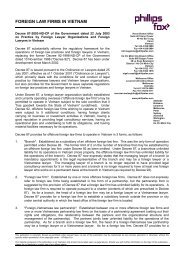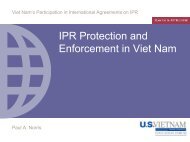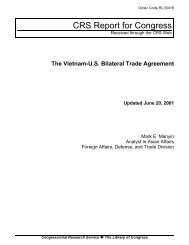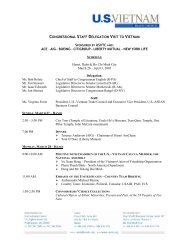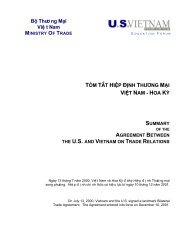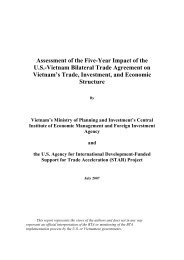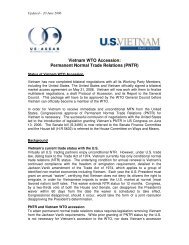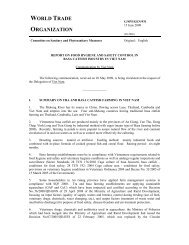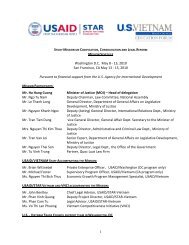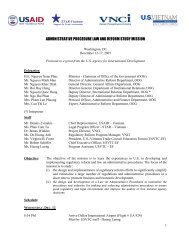Climate risks and adaptation in Asian coastal megacities: A synthesis
Climate risks and adaptation in Asian coastal megacities: A synthesis
Climate risks and adaptation in Asian coastal megacities: A synthesis
- No tags were found...
You also want an ePaper? Increase the reach of your titles
YUMPU automatically turns print PDFs into web optimized ePapers that Google loves.
uilt outside the cities <strong>and</strong> are not expected to beimpacted by floods.The Bangkok study estimates that health carecosts could double with climate change (Table 4.2).The costs from a 1-<strong>in</strong>-30-year flood could be aboutTHB 2 billion ($60 million) <strong>in</strong> 2050 with climatechange (2050-LS-SS-SR-A1FI), sea level rise, stormsurge, <strong>and</strong> l<strong>and</strong> subsidence. This is about twicethe cost that would occur <strong>in</strong> 2050 without climatechange <strong>and</strong> only l<strong>and</strong> subsidence (2050-LS). This<strong>in</strong>crease <strong>in</strong> health costs is primarily triggered bythe larger number of people likely to be affectedby floods.Daily wage earners will see significant<strong>in</strong>creases <strong>in</strong> <strong>in</strong>come losses<strong>Climate</strong> change will affect the population of workersliv<strong>in</strong>g <strong>in</strong> condensed hous<strong>in</strong>g areas <strong>and</strong> deliversignificant <strong>in</strong>come losses to daily wage earners. AsTable 4.3 shows, losses to daily wage earners arelikely to <strong>in</strong>crease by 25 percent when we consideran A1FI climate change scenario (2050-LS-SR-SS-A1FI-T30) <strong>in</strong> 2050 relative to a scenario where thereis only l<strong>and</strong> subsidence (2050-LS-T30).Table 4.3 ■ Changes <strong>in</strong> Income Lossesto Wage Earners,Commerce, <strong>and</strong> IndustryChanges <strong>in</strong> <strong>in</strong>come losses* from extreme weather (1/30 flood)under different scenarios2050-LS-SR-SS-Scenarios 2008-T30 2050-LS-T30 (%) A1FI-T30 (%)Daily wage— 11 25earnerCommerce — 266 45Industry — 168 38*Each column represents the percentage change <strong>in</strong> <strong>in</strong>come relative to the previouscolumn.However, as expected, the overall cost to low<strong>in</strong>comeworkers is very small relative to the estimatedcosts to <strong>in</strong>dustry <strong>and</strong> commerce (Table 4.2).Commercial <strong>in</strong>come losses come second only tobuild<strong>in</strong>g damages as a source of losses from floods.For <strong>in</strong>stance, <strong>in</strong> the case of a 1-<strong>in</strong>-30 -year flood <strong>in</strong> aclimate change scenario (2050-LS-SR-SS- A1FI-T30),<strong>in</strong>come losses to commerce are estimated at 21 billionTHB ($630 million).Box 4.1 ■ Exam<strong>in</strong><strong>in</strong>g Build<strong>in</strong>g Damages, Income Losses, <strong>and</strong> Health Costs <strong>in</strong>BangkokIn order to estimate the damage to build<strong>in</strong>gs, the Bangkok study developed GIS maps of areas likely to be flooded. Different categories of build<strong>in</strong>gslikely to be impacted—identified us<strong>in</strong>g National Hous<strong>in</strong>g Authority data (2004)—were overlaid on these maps. Of particular concern was condensedhous<strong>in</strong>g, which refers to clusters of more than 15 houses <strong>in</strong> an area of 1 rai. These areas, where poverty is high, were separately identified.To value build<strong>in</strong>gs, the Bangkok case study identified the book value of build<strong>in</strong>gs of different types <strong>and</strong> then depreciated these values. Damagecosts were assessed as a percentage of total value based on the extent <strong>and</strong> duration of floods. Added to this was the value of assets that may bedamaged. Average asset values associated with residential build<strong>in</strong>gs (obta<strong>in</strong>ed from census data) are THB 328,889 for Bangkok <strong>and</strong> THB 220,180 forSamut Prakarn. Build<strong>in</strong>g damages were estimated separately for residential, commercial, <strong>and</strong> <strong>in</strong>dustrial build<strong>in</strong>gs.With extreme precipitation <strong>and</strong> flood<strong>in</strong>g, <strong>in</strong>come losses can be <strong>in</strong>curred <strong>in</strong> flooded <strong>and</strong> non-flooded areas. The Bangkok study estimated threetypes of <strong>in</strong>come losses <strong>in</strong> flooded areas: (a) bus<strong>in</strong>ess <strong>in</strong>come loss, (b) <strong>in</strong>dustrial <strong>in</strong>come loss, <strong>and</strong> (c) losses to daily wage earners.To obta<strong>in</strong> bus<strong>in</strong>ess losses, the Bangkok study first identified the average <strong>in</strong>come per day from commercial establishments based on bus<strong>in</strong>esssurveys. This was then adjusted to reduce operational expenses. The average net commercial <strong>in</strong>come was estimated to be THB 4,930 per establishmentper day. A similar account<strong>in</strong>g was used to estimate average <strong>in</strong>come to <strong>in</strong>dustrial establishments. These average values are multiplied by the number ofdays of flood<strong>in</strong>g <strong>and</strong> the number of build<strong>in</strong>gs affected by floods to estimate <strong>in</strong>come losses from commerce <strong>and</strong> <strong>in</strong>dustry. Income losses to daily wageearners liv<strong>in</strong>g <strong>in</strong> condensed hous<strong>in</strong>g areas were estimated based on the population <strong>in</strong> these areas affected by floods of different <strong>in</strong>tensity.Disease outbreaks <strong>in</strong> the form of diarrhea, cholera, typhoid, <strong>and</strong> other diseases are possible dur<strong>in</strong>g times of flood, depend<strong>in</strong>g on the duration<strong>and</strong> nature of the areas affected. But few estimates are available of the likelihood of these outbreaks <strong>and</strong> what populations may be affected. In theabsence of disease <strong>and</strong> cost <strong>in</strong>formation, the average cost of hospitalization <strong>in</strong> Bangkok <strong>and</strong> Samut Prakhan was used as a proxy for public healthcosts. These costs, which are THB 7,582 <strong>and</strong> THB 3,756 per person per admission <strong>in</strong> the two regions respectively, were multiplied by 50 percent of theaffected population to get health damages.Assess<strong>in</strong>g Damage Costs <strong>and</strong> Prioritiz<strong>in</strong>g Adaptation Options | 55



